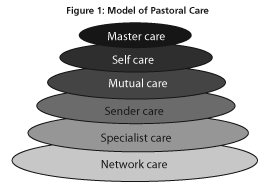Pastoral Care of Missionaries: Turning Theory into Practice

by David Williams
A case study of how the Church Missionary Society of Australia has worked to develop a model of best practice in the pastoral care of missionaries.
How do you turn formal, academic research into useful, practical guidelines in your organization?
Today’s mission community has unprecedented amounts of research available at its fingertips. However, we often struggle to know what to do with this information. How do we appropriate it and use it in the development of our ministries?
We have been particularly blessed by the research of the World Evangelical Alliance Missions Commission (WEA-MC). The two Reduction in Missionary Attrition Projects (ReMAP I and II), which have listened respectively to the voices of over thirteen thousand missionaries and almost forty thousand missionaries, provide an extraordinary depth of insight into what constitutes best practice for sending agencies. The WEA publications in the Globalization of Missions Series that have emerged from this research are key resources for mission agencies (see Taylor and World Evangelical Fellowship 1997; O’Donnell 2002; Hay 2007). Individual agencies face the challenge of working out what to do with this wealth of information. This article describes the experience of the Church Missionary Society of Australia (CMS-Australia) as we have worked to develop a model of best practice in the pastoral care of missionaries.
CMS-Australia and Pastoral Care
This story stretches back to early 2007, when CMS-Australia formally reviewed the pastoral care we provide for our missionaries. We are an organization that has a specific focus on long-term mission service. Among other things, we seek to provide high-quality pastoral care as a key strategy that enables missionaries to survive and thrive in long-term service. Our review of pastoral care in 2007 suggested that our provision of pastoral care was okay. We were not happy about this, as we pride ourselves in doing much better than okay!
We were operating a number of well-established pastoral care programs that included on-field pastoral visits, formal debriefing, and provision of training when on home assignment. As we sought the input of our missionaries, we found that their experience of pastoral care was less integrated and holistic than we expected. As we reviewed their feedback, we noticed several trends:
• Missionaries who felt that pastoral care was their own responsibility were far more likely to be satisfied than those who felt their pastoral care was CMS-Australia’s responsibility.
• Missionaries who felt that pastoral care was proactive and preventative were far more likely to be satisfied than those who felt that pastoral care was reactive and problem solving.
A few missionaries felt the overall pastoral care provision was excellent, even though they didn’t value some of the inputs given by CMS-Australia. As we reviewed this feedback we were faced with two uncomfortable realities. First, although we talked about pastoral care extensively, as an organization we did not have a formal definition. Therefore, different people in the organization were sometimes talking about different things. Second, we did not have a formal model of pastoral care that took into account the variety of sources from which missionaries receive pastoral care. As an organization, we knew what we offered in terms of pastoral care for our missionaries; however, our missionaries received pastoral care from a wide variety of people and agencies as well as from us. We needed a model that encompassed this reality.
Toward a Definition
Our first step was to define “pastoral care.” With the help of David Peterson from Moore Theological College in South Wales, our senior staff team worked to develop the following definition:
Pastoral care is “God’s holistic care for His flock, in part shared with His under-shepherds and with His sheep, to sustain, nurture and mature His people until they reach His heavenly kingdom.”
You could almost hear the sighs of relief as we finally crafted these words. Pastoral care is ultimately God’s responsibility and we rejoiced in a thoroughly theocentric definition.
We also felt that our definition captured the significant relationship between pastoral care and faithful discipleship—a relationship we knew existed but that we had not articulated with this degree of clarity. Developing a theocentric and holistic definition of pastoral care has been a practical help for us in a number of ways. First, it has given us a context in which we can balance the proactive and reactive elements of pastoral care. Second, it has clarified that, as an organization, we should expect our missionaries to receive pastoral care from many sources, not just from us. Third, it has reminded us that we cannot control every eventuality that our missionaries might face, but we have a Father in Heaven who can.
Developing a Model of Pastoral Care
Our second step was to develop a model of pastoral care that made sense both of our definition and of the experience of our missionaries. We have used the model of pastoral care offered by Kelly O’Donnell (2002, 13-22) that is developed in Worth Keeping (Hay et al. 2007, 182-183). We have adapted the model slightly to fit our own context, but it remains largely unchanged. The model is best imagined as a fountain, with water flowing from the top (“Master Care”) and flowing out to each subsequent level. Master care is the source and center of all pastoral care (see Figure 1 below).

• Master care is God’s care for his children, the affirmation that God cares for his flock and that pastoral care is his responsibility.
• Self care is the care of every Christian person for him or herself and his or her family, the responsibility each of us has for our own spiritual lives.
• Mutual care is the care Christians receive from the local congregation of believers that scripture expects us to meet with regularly.
These first three levels of pastoral care are normative for all Christians, not just for missionaries. The outer three circles describe the provision of pastoral care that is specific for missionaries.
• Sender care is the care offered by CMS-Australia and by the missionary’s sending churches.
• Specialist care is the care we outsource to specialist agencies (e.g., formal psychological support).
Between them, sender care and specialist care need to provide adequate provision in the areas of pastoral and spiritual care; physical and medical care; ongoing training and professional development; team building; family and Missionary Kid support; financial and logistical support; crisis care and contingency planning; and finally, counseling and psychological support (O’Donnell 2002, 18).
Network care is the care provided by international member care networks that help provide and develop strategic, supportive resources. CMS-Australia commits to listen to and learn from these networks, and where possible, to contribute to them.
From Theory to Practice
This model of pastoral care is nothing new. The challenge, however, is to find ways to work out the model in the day-to-day experience of our missionaries and in the practical provision of pastoral care within the organization.
The model clarifies different levels of responsibility of pastoral care. Self care reminds us that we are responsible, under God, for our own spiritual lives and the lives of our families. Master care and self care are the two central rings that the other levels are subsumed under. This reality has encouraged CMS-Australia to encourage missionaries to be the lead people in planning their pastoral care. We have therefore turned the model of pastoral care into a template which missionaries use to develop their own personalized “Personal Pastoral Care Plan” (PPCP).
Missionaries draft their own PPCPs and then refine and develop these plans in consultation with the personnel team. The degree of input and refinement needed from the personnel team will vary at different stages of the missionary lifecycle, with new missionaries requiring greater support than established missionaries. Experienced long-term missionaries are able to include within their PPCP the extensive support they may be receiving from local colleagues, their local church, or their team.
For missionaries who are just starting in a new location, the template highlights potential gaps in pastoral care provision. For example, the level of mutual care—receiving pastoral care from a local church—will be very limited in the early days of language acquisition. Recognizing this reality as the PPCP is developed, the missionary and CMS-Australia will find ways to mitigate this relative lack of pastoral provision in the early months or years of ministry by strengthening other aspects of pastoral support.
The strength of using the formal model as a way of planning pastoral care is that it enables provision of care by different partners to be integrated. From the point of view of CMS-Australia, it enables us to have one policy that is highly flexible, recognizing the variety that exists between different missionaries serving in different locations. Perhaps the easiest way to illustrate this is to show a template of a PPCP (See sidebar on pages 431-432).
Conclusion: Lessons Learned
We have used this template as a way of planning pastoral care provision over the past few years. Out of this experience we are learning a number of lessons.
Ownership. Missionaries have found it encouraging and empowering to be “lead people” in the planning of their pastoral care provision. We continue to work through a significant change in mindset as we think about pastoral care as something a missionary helps to plan rather than something that is done to a missionary. This is not to say that the responsibility for pastoral care is put onto a missionary’s shoulders. However, it is a recognition that experienced missionaries are ideally placed to articulate their pastoral care needs and to identify the best ways in which those needs might be met.
Dynamism. The PPCP is intended to be a living, dynamic document that is reviewed regularly and adapted as needed. If a missionary’s circumstances change, the PPCP can be reviewed and changed to take account of the new situation. This is largely possible because the missionary “owns” the document.
Proactivity. Prevention is better than cure. The PPCP aims to put in place appropriate measures that will enable a missionary to thrive on location—and care that will prevent burnout, rather than care that needs to be done once burnout has taken place.
Accountability. The PPCP seeks to build structures of accountability into pastoral care provision. We have chosen to use the concept of an accountability partner who stands outside of the professional structures of the mission organization.
Gap Analysis. By following a formal model for pastoral care, we find it easier to identify potential gaps in provision of care for some of our missionaries. This highlights the need to compensate for these gaps by bolstering other levels of care.
Evaluation. This process grew out of an evaluation process that was challenging and uncomfortable. CMS-Australia is slowly learning the value of self-assessment and review, and the benefits that can flow out of this.
Transferability. CMS-Australia has received a great deal of interest in the concept of a PPCP, not only from other mission agencies but also from local churches and denominations. These groups see the value of proactively planning pastoral care for pastors and other church leaders.
References
Hay, Rob, Valerie Kim, Detlef Blöcher, Jaap Ketelaar, and Sarah Hay. 2007. Worth Keeping: Global Perspectives on Best Practice in Missionary Retention. Pasadena, Calif.: William Carey Library.
O’Donnell, Kelly. 2002. Doing Member Care Well: Perspectives and Practices from around the World. Pasadena, Calif.: William Carey Library.
Taylor, William and World Evangelical Fellowship. 1997. Too Valuable to Lose: Exploring the Causes and Cures of Missionary Attrition. Pasadena, Calif.: William Carey Library.
……………………………………………………………………………….
Personal Care Plan — Template
Imagine that John Smith is married to Jane; they have two children and work in East Africa.
This document outlines the pastoral care plan for John Smith, as agreed between John and CMS-Australia. This plan will form the basis of pastoral care planning and provision for John and his family, in conjunction with Jane’s pastoral care plan. The plan follows the structure of CMS-Australia’s model for pastoral care of missionaries, which is illustrated below.
Timeframe: This PPCP is written for the period from April 2009 to March 2012. It therefore covers the next three years of field assignment. This is a living and dynamic document. I (John) will develop and update my PPCP as necessary, in communication with the CMS-Australia personnel team.
1. Master Care:
1. I believe that the Lord Jesus Christ is the Great Shepherd of his sheep. I entrust myself and my family to the care of the Master Shepherd, confident of our Lord’s loving kindness, covenant faithfulness, and sovereign rule over all our lives.
2. Self Care:
1. I believe that individual Christians are responsible for their own spiritual growth and maturity. I will therefore continue to practice habits and disciplines that ensure that I am listening to God’s word and growing in prayerful faithfulness to the Lord Jesus. Specifically, I will:
1.1 (John writes in detail of his intended devotional habits and disciplines, ways to receive regular Bible teaching, retreats, etc.; he considers areas of personal godliness that he is seeking to grow in and any other personal areas in which he would like to be held accountable.)
2. As a husband and father, I will practice habits and disciplines with my family to help us to grow together in our love for the Lord Jesus. Specifically, I will:
2.1 (John writes in detail of intended family and marriage devotional habits, ways to encourage and teach his children, and other disciplines in which he would like to be held accountable.)
3. I would like to be held accountable to these disciplines by my accountability partner (see 4.2.4).
3. Mutual Care:
1. I believe that God lovingly provides us with other Christians who encourage us to go on trusting the Lord Jesus. I will receive pastoral care and encouragement in my local setting in the following ways:
2. (John writes in detail of his local church involvement on field location, including Sunday church attendance, small group Bible study, and prayer support. He includes details of any pastoral care he receives from his local team/colleagues. He might include details about a prayer partner, whether local or expatriate; a mentor, whether local or expatriate; and any other small group or individual pastoral involvement.)
3. (If the time period covered by this PPCP includes home assignment, John might write in detail of the pastoral support he will receive at his home church.)
4. I would like to be held accountable to these disciplines by my accountability partner, (see 4.2.4).
4. Sender Care:
1. Jane and I are linked to the following churches, which support us in the following ways:
1.1 (John lists his sending church(es) and outlines the pastoral care that he and his family receive from these churches. This information is developed in conversation with the pastor(s) of the church(es), who keep a record of what has been agreed.)
2. CMS-Australia takes its responsibility as a sending agency seriously. The full details of our provision of pastoral care for missionaries are explained in “Guidelines for Missionaries.” We note the following specific provisions for John and his family:
2.1 (John and his personnel director list details of on-field pastoral visits.)
2.2. (John and his personnel director list details of skype/phone contact plans.)
2.3. (John and his personnel director list details of any contingency plans that need to be put in place in the event of a crisis.)
2.4. (John names his “accountability partner,” a personal friend to whom he will be accountable as described in Sections 2 and 3, the frequency of contact, etc.)
5. Specialist Care:
1. CMS seeks specialist assistance in pastoral care in some situations. These are outlined in general terms in “Guidelines for Missionaries.” However, we note the following specific provisions for John:
1.1. (John and his personnel director list details of interventions in which specialist care is sought. This includes mandatory formal debriefing, counseling support if required, spiritual retreats, team development, marriage enrichment seminars, MK retreats/conferences, etc.)
6. Network Care:
1. CMS has put in place structures that will help us listen to networks of specialist care for missionaries and listen to and contribute to those networks.
2. CMS commits to John and his family to keep on reviewing our provision of pastoral care against network models of best practice in order to provide the best pastoral care possible for our missionaries.
……………………………………………………………………………….
David Williams leads the development and training team for the Church Missionary Society of Australia. He and his family served as missionaries for nine years in Nairobi. Based at Carlile College, David led a team that pioneered new training initiatives for pastors serving in the city’s informal settlements.
EMQ, Vol. 46, No. 4, pp. 426-432. Copyright © 2010 Evangelism and Missions Information Service (EMIS). All rights reserved. Not to be reproduced or copied in any form without written permission from EMIS.



